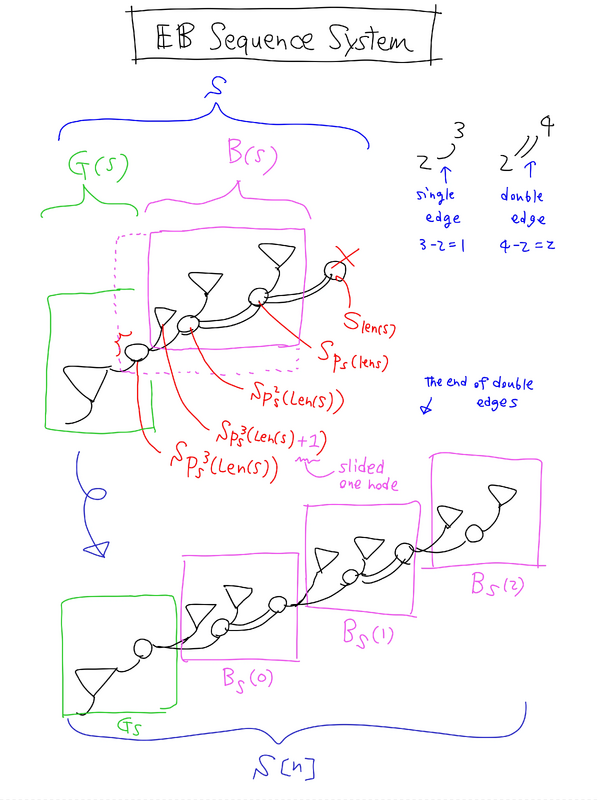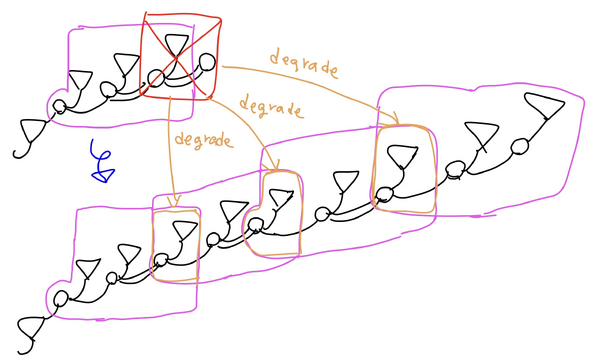\( \newcommand{\bm}[1]{\boldsymbol #1} \newcommand{\len}{ {\rm len}} \newcommand{\cutlen}{ {\rm cutlen}} \newcommand{\if}{~{\rm if}~} \newcommand{\nat}{ {\mathbb N} } \)
I made a large number named "True EB Sequence System Number" on Sept. 29-Nov. 9, 2020 in Japanese Googology Wiki. It's the translation in English.
I'm selling it in opensea, which is the largest NFT market.
Can it be the first sold natural number?
Notation[]
I defined a notation which is finite natural number sequence \(FT\) as the following.
- \((1) \in FT\)
- \(\forall k\in \nat~(1 \leq k \rightarrow (1,\underbrace{2,4,6,8,10,\cdots,2k}_{k}) \in FT)\)
I defined the set of True EB sequence \(OT\) as the following.
- \(FT \in OT\)
- \(X \in FT \rightarrow X[b] \in OT\)
Fundamental sequence[]
I defined the fundamental sequence-expansion function
\begin{eqnarray*} [~] \colon OT \times \nat & \to & OT \\ (S,n) & \mapsto & S[n] \end{eqnarray*}
as the following.
\begin{eqnarray*} S[n]&=&\left\{\begin{array}{ll} () & {\rm if}~S=() \\ S_1 \frown S_2 \frown \cdots \frown S_{\len(S)-1} & {\rm if~} S_{\len(S)}=1\\ G_S \frown B_S(0) \frown B_S(1) \frown \cdots \frown B_S(n) & {\rm otherwise}\\ \end{array}\right.\\ S\in OT&=&(S_1,S_2,\cdots,S_{\len(S)})~(\forall kS_k \in \nat))\\ G_S &=& (S_1, S_2, \cdots, S_{r_S-1})\\ \forall k~B_S(k) &=& (S_{r_S}+k\Delta_S, S_{r_S+1}+k\Delta_S, \cdots S_{\len(S)-1}+k\Delta_S) \\ r_S &=& \left\{\begin{array}{ll} p_S(\len(S))&\if S_{\len(S)}-S_{p_S(\len(S))}=1\\ p^{k+1}_S(\len(S))+1 & \if S_{\len(S)}-S_{p_S(\len(S))}=2\\ &(k=\min\{a \in \nat|a\geq 0 \land S_{p^a_S(\len(S))}-S_{p^{a+1}_S(\len(S))}=2\}) \end{array}\right.\\ p_S(x) &=& \max\{a \in \nat|1\leq a \lt \len(S) \land S_a \lt S_{\len(S)}\}\\ \forall k~p_S^{k+1}(x)&=&p_S(p_S^k(x))\\ p_S^0(x)&=&x\\ \Delta_S&=&S_{\len(S)}-S_{p(S)}-1 \end{eqnarray*}
\(\len(S)\) is the number of the elements of \(S \in OT\) .
FGH[]
I defined a function \begin{eqnarray*} f \colon S \times \nat & \to & \nat \\ (S,n) & \mapsto & f_S[n] \end{eqnarray*} as the following.
- \(f_{()}(n)=n\)
- \(f_{S}(n)=f_{S[g(n)]}(g(n)) \if S\neq ()\)
- \(g(n)=n+1\)
Large number[]
I named the natural number written by \(f^{10^{100}}_{(1,2,4,6,8,10,12,14,\cdots,10^{100})}(10^{100})\) as "True EB Sequence Number".
Explanation by hydra diagram drawing[]

Explanation of EBSS by hydra diagram
| -informal plaza- |
|---|
| \(S_{p_S(x)}\), The parent of \(x\) in \(S\), is the rightmost number in the left of \(x\).
When you write in the hydra diagram, the parent and child with the difference in more than 1 are connected by doubled edge. The parent and child with the difference in 1 are connected by a single edge. \(S_{p^k_S(x)}\), the ancestor of \(S_x\) is defined recursively as \(S_x\) itself or the parent of ancestors. (I mean, all of itself \(S_x\), its parent \(S_{p_S(x)}\), the parent of its parent \(S_{p_S(p_S(x))}\), the parent of the parent of its parent \(S_{p^3_S(x)}\) ... are ancestors.) When The difference between the cut child and its parent \(S_{\len(S)}-S_{p_S(\len(S))}\) is 1, The parent of the cut child is defined to be "bad root". When the difference is 2, the left node of the parent of the rightmost ancient which can be tracking only by double edges is defined to be "bad root". "bad part" is the sequence from bad root \(S_{r_S}\) and the left of the cut child. The left sequence in the left is defined as "good part" \(G_S\). You cut the rightmost node \(S_{\len(S)}\) o \(S\) and copy the bad part in n times and it should be \(S[n]\). The reason of bad root and bad part is because the copy was done not only for cut children but also its parent with a little bit overwrap. At the moment, duplicated part should be connected by the "degraded" family of the parent of the cut child. |

Explanation of EBSS by hydra diagram

